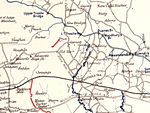Fair Oaks, Henrico County, Virginia
Central Virginia geography stubsUnincorporated communities in Henrico County, VirginiaUnincorporated communities in VirginiaUse mdy dates from July 2023
Fair Oaks is an unincorporated community located in Henrico County, Virginia. Fair Oaks Station was located on the Richmond and York River Railroad and played a role in the Peninsula Campaign in 1862 during the American Civil War. A major battle was fought nearby, known variously as the Battle of Fair Oaks or the Battle of Seven Pines.
Excerpt from the Wikipedia article Fair Oaks, Henrico County, Virginia (License: CC BY-SA 3.0, Authors).Fair Oaks, Henrico County, Virginia
Brick Drive,
Geographical coordinates (GPS) Address Nearby Places Show on map
Geographical coordinates (GPS)
| Latitude | Longitude |
|---|---|
| N 37.530833333333 ° | E -77.316111111111 ° |
Address
Brick Drive 40
23075
Virginia, United States
Open on Google Maps







